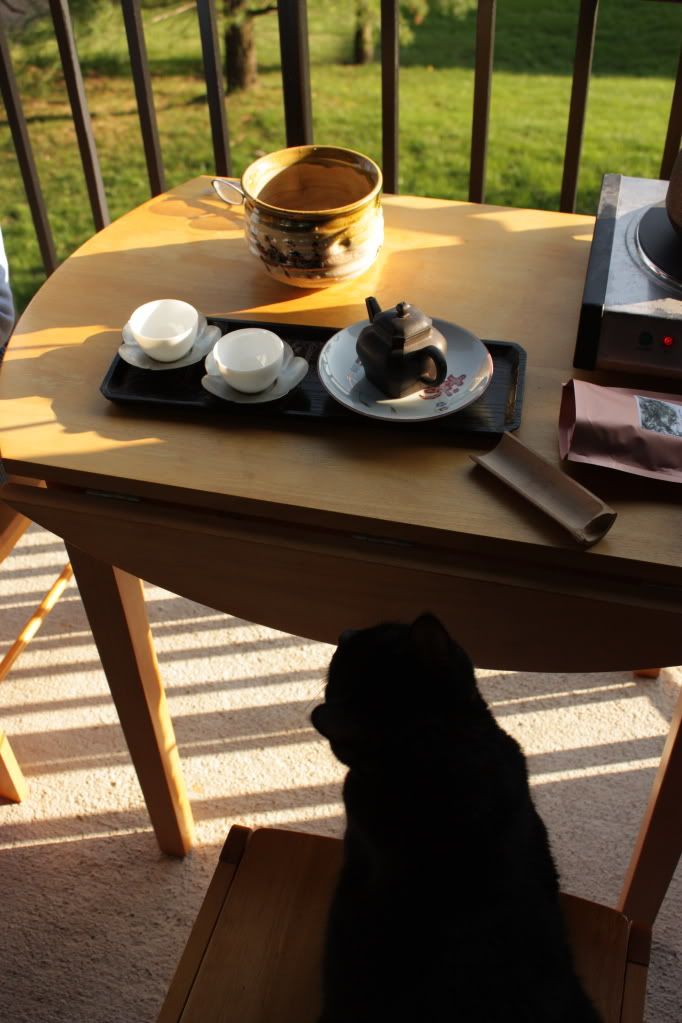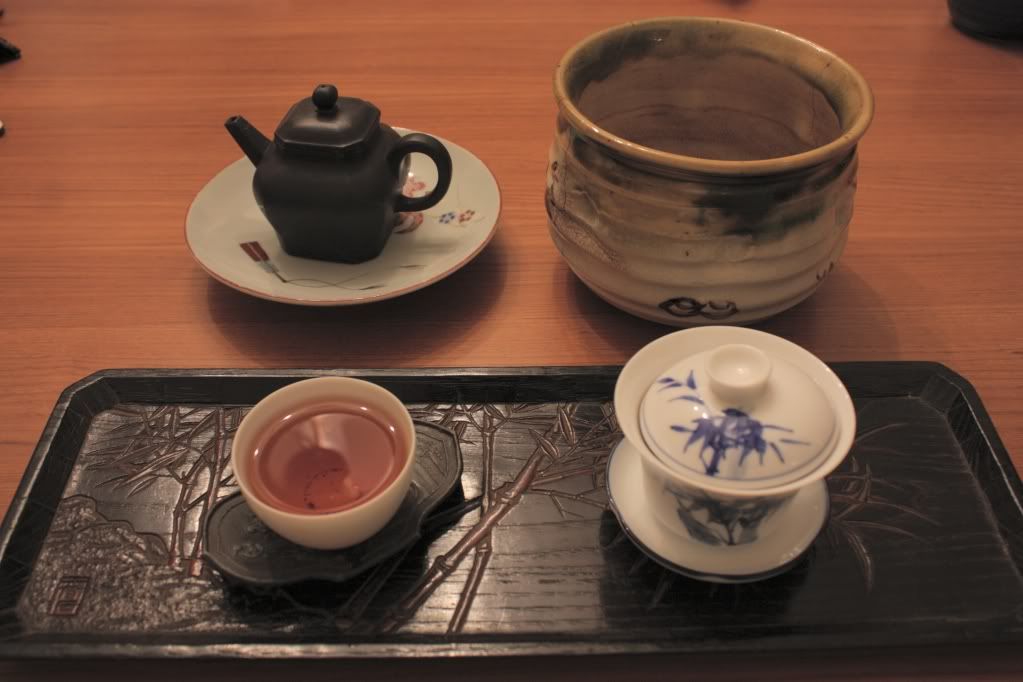First of all — the result of the last little question is in, and trentk, you should email me (marshaln at gmail). Chaozhou, yixing, tokoname indeed — or some other variation of Japanese clay pot.
Now, yesterday was a nice day, so we had tea outside, with tea mistress in training handling the brewing duties

It was a good session, drinking some old Wenshan baozhong that I traded a little Japanese bizen teapot for. This is somewhat roasty, but not too roasty stuff. Nice aged taste.
Now, today, after dinner, we had the same thing, but I used a gaiwan.

I haven’t touched my gaiwans for a long time, other than to occasionally brew something very casually using that large sipping gaiwan. I thought I would make a video about using gaiwans — boiling it down to the basics, using as simple a process as possible. So, I figured I need a little practice.
Hmmm, boy did I forget how teas taste with gaiwan. No wonder I haven’t used one in ages — it just doesn’t work, at least not with teas like this. I am not sure what exactly it is that makes it taste different — there are, after all, a lot of variables involved, but I can say pretty confidently that when I had the first cup, it tasted flat and lacking any depth. I was not happy with what resulted.
So why use a gaiwan? Simple, convenient, and functional. As easy teaware goes, it doesn’t get much better than a gaiwan. As good tasting tea goes, however, I think a pot will beat a gaiwan any day.

 RSS - Posts
RSS - Posts
14 responses so far ↓
Anonymous // May 3, 2009 at 2:18 am |
for one kind of tea i really like to use a gaiwan: young sheng puer. when using a pot (of mine) even if i pour the tea out instantly with practically no steeping time, the water-leaf contact for some teas is too long. the gaiwan makes it possible to pour out instantly for real. i had a very impressive experience with some xiaguan ft nan zhao bing cha. brewed in a pot it was unpalatable bitter, brewed in the gaiwan it was floral and delicous.
best wishes,
bert
iwii // May 3, 2009 at 5:22 am |
So you were the one who kidnapped Hobbes’ fleabag!!
Anonymous // May 3, 2009 at 8:07 am |
Marshal, I really enjoy your tea blog. Thanks for taking the time to capture so beautifully your life with tea!
smbushberg // May 3, 2009 at 9:44 am |
Marshall, what about glass teapots. Would you put them closer to the gaiwan in terms of their impact on taste? Contributes additional value via visual cues, but not taste?
Anonymous // May 3, 2009 at 10:35 am |
Looking forward to the gaiwan vid. Why not a yixing video as well? I’m sure it would be just as helpful to some of us.
MarshalN // May 3, 2009 at 12:43 pm |
Bert: That’s interesting. You ever tried using less tea but in a pot, and compare the results? It also probably depends on the tea in question as well.
Iwii: She’s not a fleabag!
Steve: Thanks!
SMBushberg: I don’t actually think glass teapots are at all useful in any meaningful way. There’s really not a lot you can see from the leaves through the glass — sure, the leaves expand, but you don’t need to see it to know that, and how it expands really doesn’t add any information that you need in terms of brewing. I’d stick to a gaiwan for more control, or a clay pot of some sort for any potential benefits in taste/texture.
Anon: Why not a yixing vid? I don’t know. I thought gaiwan is more basic and we’d start with that first. The stuff on Youtube tend to be overly elaborate.
Anonymous // May 4, 2009 at 1:47 pm |
Beautiful color to the tea.
I am not as experienced using clay pots as yixings or indeed the glass pot I’m using these days for black teas (that I think of as a giant gaiwan). However, would you say that perhaps clay pots are better for aged or roasted teas than for a really floral or green oolong? Thanks.
Anonymous // May 4, 2009 at 2:18 pm |
Ok so… I think I said this one time before.
When I was looking for video on gongfu brewing, I found one that I thought made alot of sense.
What she did was brew the tea in a medium gaiwan, and decanted into a small yixing pot to pour at leisure.
My thought was that it would give you the control of gaiwan brewing, but the advantage of yixing teapot. It also would not penalize you if you used a single hole teapot. I suppose a yixing fairpot or cups would also work similarly. My only gripe ever with yixing pots is that you don’t get to see the color of the tea as you steep to get a sense of how much it’s brewed, and you dont get to play with the leaves like you can with a gaiwan lid.
I never really got into that habit though since it ends up being more to clean up.
lewperin // May 4, 2009 at 3:17 pm |
I wonder if anyone’s played with an unglazed gaiwan like this one? (They don’t claim it’s zisha or any other aristocratic mud.)
Anonymous // May 4, 2009 at 5:34 pm |
MarshallN,
I agree completely.
While I do believe that gaiwans offer precise control over brewing parameters (thereby enabling one to make a great cup more often than not), once mastered, yixing pots can take tea to new heights (but only through the skill of the brewer as they can also make a bad cup even worse in the wrong hands). When a specific tea and its matching pot find each other under the proper circumstances, magic occurs. As I brew hongcha in a gaiwan, it is indeed tasty but the flavors within the liquor are bit crowded… slightly sharper than they should be. If the same tea is brewed well in my beloved fifty year old 120 cl zhuni yixing teapot, the brew reeks of qi and tasting it is like stepping through an open forest. The flavors and energy simply seem to have more room to breathe and exist.
-Tyler
MarshalN // May 5, 2009 at 8:28 pm |
Janine: Yes, generally speaking.
Walt: I think the thing with decanting into a Yixing is that… I’m not convinced the usefulness of Yixing is having the tea pass through the pot. I think it has more to do with the way the pot interacts with the brewing process — which means passing the tea through the pot is not all that useful.
Lew: Never used those things, but I can see how they might work.
Tyler: Yup – my thoughts exactly. It makes tea better…. even mediocre tea.
Anonymous // May 6, 2009 at 12:14 am |
It’s interesting I always held a similar opinion although most people would disagree with me. I think a gaiwan is only suitable for the most tender green (such as long jing) or white teas. I use a decent porcelain teapot for most green teas. Gaiwan-made tea (or Gaiwanese, as my family refers to it) is sometimes too flat for my taste. Besides, I think there are certain teas where most flavor only comes out with a touch of bitterness.
I personally didn’t found an unglazed clay gaiwan satisfying but it is as convenient as only a mule can be :). Also IMHO, a glass gaiwan is fairly useless (nothing to see there, really) but I do enjoy using a glass pitcher.
Anonymous // June 21, 2009 at 10:55 pm |
When it comes to the way a tea comes out in a gaiwan, it seems that the type of porcelain can make a huge difference. Until recently I had only used the cheap mass-made gaiwans that are very even and thin. Then I got one that I suspect is bone china, and if you look closely you can see very light rings and such in the surface of the porcelain. Have you tried one of these?
This new gaiwan produced far more round and full tea with better aroma than I had ever encountered in a gaiwan before. This gaiwan seems to even do better than pots for some teas. After getting used to this gaiwan I tried using one of my mass-made gaiwans again and I found the same thing that you mention – thin tea lacking in depth. Of course my good gaiwan still can’t hold a candle to a yixing pot when it comes to the heavier roasted teas.
This new gaiwan is something that I got in a local shop. It was just sitting on a shelf with no information and I got it purely for the size at the time (it’s about 60ml), and there are no markings on it. So I can’t say for sure whether it’s actually bone china or not but it’s definitely different than the standard mass produced ones. Talking with someone that got one of the bone china ones from Tea Gallery, however, has made me think that it is (from both the qualities of the gaiwan itself and the results it produces). It would also actually make some sense that adding bone to the porcelain would change its (thermal?) properties; I can’t really account for the difference otherwise.
Anyway, I just thought I’d throw that out there because I had pretty much thought the same about gaiwans until I found this one (I thought pretty much exactly the same words). This was one of those teaware purchases that had me rediscovering a lot of my teas – aged wulong especially. I’m sure that the mass produced ones are fine for things like green tea, and I think that that’s really what they’re made for. I do have a couple of teas that still actually come out better in my $3 gaiwans, though.
Anonymous // June 16, 2010 at 3:37 am |
I have to disagree with you on a pot better than a gaiwan. Although i do like a pot of tea, gaiwan just has that edge to it.